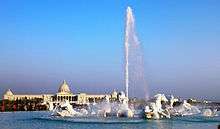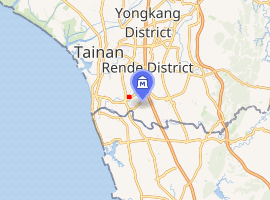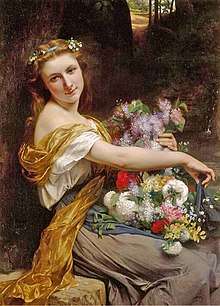Chimei Museum
The Chimei Museum (Chinese: 奇美博物館; pinyin: Qíměi Bówùguǎn; Wade–Giles: Chʻi²-mei³ Po²-wu⁴-kuan³) is a private museum established in 1992 by Shi Wen-long of Chi Mei Corporation in Rende District, Tainan, Taiwan. The museum's collection is divided into five categories: Fine arts (including painting, sculpture, decorative arts and period furniture); Musical instruments; Natural history and fossils; Arms and armor; Antiquities and artifacts. The museum is known for housing the world's largest violin collection and for its significant collections of ancient weapons and sculptures.[2][3] Forbes magazine, in its February 1996 article on private collectors in Asia, called the Chimei Museum "one of the world's most surprising art collections."[4] The museum moved to its current venue on Wenhua Road in 2014, and it is open to the public except on designated days.
臺南都會公園奇美博物館 | |
 | |

| |
| Established | 1992 |
|---|---|
| Location | No. 66, Sec. 2, Wenhua Rd., Rende, Tainan 71755, Taiwan |
| Coordinates | 22°56′4.53″N 120°13′33.23″E |
| Type | Museum |
| Visitors | 1.5 million (2015)[1] |
| Director | Ling-Ling Kuo |
| Website | www.chimeimuseum.org |
Background
The museum was first established and housed in an administration building of the Chi Mei Corporation in 1992 by the company's founder Shi Wen-long, then relocated to the Tainan Metropolitan Park in 2014, and reopened in 2015.[5] Shi is known for his collection of antique violins housed in the museum. Besides being an entrepreneur, Shi is also an amateur violinist who has performed in public many times. To improve the level of classical music and western art in Taiwan, he founded the Chi Mei Culture Foundation in 1977 and has been providing scholarships through the Chimei Arts Award to developing artists in both classical music and fine arts since 1988.[6]
Exhibitions
The museum has several exhibition areas, including fine arts, natural history and fossils, arms and armour, musical instruments, and sculptures. The museum has a collection of European paintings from the 13th to the 20th century, presenting the development of western art. The historic weapon exhibition presents weapons from prehistoric time, the Bronze Age, the Iron Age to modern times.
Musical instruments
The museum collects musical instruments of historical significance, in particular violins and other string instruments by Antonio Stradivari, Guarneri del Gesù, Jacob Stainer, Amati, Rogeri, Joseph Guarneri Filius Andrea, Vincenzo Rugeri, Seraphin, Gagliano, Guadagnini and other famous artisans.[7] The collection is noted for the Guarneri del Gesù "Ole Bull" violin of 1744, which is believed to be the last work of Guarneri del Gesù.[8] As of 2019, the museum houses more than 1,370 violins and has allowed more than 3,000 violinists to borrow from the collection, with more than 220 violins out on loan.[9][10] The museum loans the antique instruments to distinguished musicians free of charge. In 1999, Yo-Yo Ma borrowed the Pawle Stradivarius cello for a concert in Taipei.[11][12] In 2015, Yu-Chien Tseng won the silver prize (no gold prize was awarded)[13] at the 15th International Tchaikovsky Competition with the Castelbarco-Tarisio Guarnerius violin from the museum.[14][15]
Artworks

- The Madonna of Humility - Paolo di Giovanni Fei (Italy, 1345-1411)[16]
- Suffer the Little Children to Come unto Me - Lucas Cranach the Younger (Germany, 1515–1586)[17]
- Saint Martin and the Beggar - El Greco (Spain, 1540/50-1614)[18]
- Charity - Jacques Blanchard (France, 1630-1638)[19]
- The Last Tears - Narcisse Virgilio Díaz de la Peña (France, 1807–1876) [20]
- Charity - Friedrich von Amerling (Austria, 1803-1887)[21]
- The Blessing of the Wheat - Jules Breton (France 1827-1906)[22]
Reproductions from the museum
The museum has offered reproductions such as canvas posters, simulating sculptures made from bonded marble powder, stationery items and many classic CD recordings performed by top Taiwanese musicians on the rare instruments from the Chi Mei Collection since 1997. The museum has also published the hardcover book "Chi-Mei Collection of Fine Violins" featuring 15 world-famous string instruments made by the Italian violin makers of the 17th century.[23] Through the Shining Collection in New York, one can inquire about and purchase these reproductions.
A replica of Bassin d'Apollo greets the visitors at the museum entrance. The same-scale replica was unveiled in 2014. The museum commissioned French artist Gills Perrault in 2008 to reproduce the Fountain of Apollo, same as the one in Palace of Versailles. It took three years for modern laser measuring and the plaster mold to be made in France for the reproduction sculpture, and another three years to carve the marbles in the city of Carrara, Italy.[24]
Location and Hours
The museum address is: No. 66, Section 2, Wenhua Rd., Rende District, Tainan, Taiwan. The museum is open to the public from 9:30 am to 5:30 pm, and it is closed on Wednesdays and other designated days.
Transportation
The museum is accessible within walking distance from Bao'an Station of the Taiwan Railways.
References
- 吳俊鋒. "奇美博物館入場券 今年春節還是很搶手". Liberty Times. Taiwan. Retrieved 10 March 2016.
- Taiwan's museum 'for the poor' home to world's largest violin collection
- Tainan's new CHIMEI museum opens with focus on Western art
- Chi-Mei Museum, Forbes, February 1996.
- "About CHIMEI Museum". CHIMEI Museum. Retrieved 20 March 2019.
- "CHIMEI Museum Temporary Exhibition, Hyperrealism Art in Taiwan". CHIMEI Museum. 20 March 2019.
- Chimei Museum Instrument Database
- Giuseppe Guarneri del Gesù, 1744
- Chimei Museum promises to continue loan of violins
- Lost in the treasures
- The Magnate And His Music
- Antonio Stradivari ca.1730
- "Results of the XV International Tchaikovsky Competition in the Violin category have been announced!". tchaikovskycompetition.com. Retrieved 18 July 2015.
- Taiwan, Today. "ROC violin talent gets leg up from Chimei Museum".
- Giuseppe Guarneri del Gesù, 1732
- Website of the Museum
- Website of the Museum
- Website of the Museum
- Website of the Museum
- Website of the Museum
- Website of the Museum
- Website of the Museum
- Chi-Mei Collection of Fine Violins, Chi-Mei Museum.
- Fountain of Apollo sculpture unveiled in Tainan
External links
| Wikimedia Commons has media related to Chi Mei Museum. |